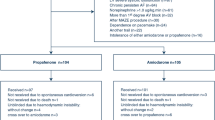Abstract
Objective
To evaluate the incidence of prolongation of the rate-corrected electrocar diographic QT interval (QTc) and of ventricular arrhythmia associated with intravenous administration of erythromycin lactobionate.
Design
A consecutive series of 7 critically ill patients treated with intravenous erythromycin for severe pneumonia.
Setting
A medical intensive care unit of a university hospital.
Measurements and results
Registration of QTc duration before and after intravenous administration of erythromycin as a short infusion. Blood chemistry, hemodynamic variables, arrhythmias, and co-medications were recorded., Evaluation of at least 10 ECG intervals by 2 experienced investigators who were blinded as to the time of drug administration If several measurements were performed in the same patient, only the mean value was used for further analysis. During 12 of 13 drug administrations studied in 7 patients QTc prolongation was observed. The extent of QTc prolongation was significantly correlated with the infusion rate (mg/min,r=0.765,p=0.05). In 3 patients ventricular arrhythmia occurred in close temporal relation to the erythromycin infusion; two of them developed ventricular fibrillation shortly after the first and second dose of erythromycin, respectively, and died within 3 h.
Conclusion
In critically ill patients erythromycin-induced QTc prolongation is a frequent pharmacologic effect correlated with erythromycin infusion rate. To avoid changes in electrocardiographic intervals and thereby possibly potentially life-threatening ventricular arrhythmia administration with the lowers possible infusion rate and close cardiac rhythm monitoring are advisable in these patients.
Similar content being viewed by others
References
Brittain DC (1987) Erythromycin. Med Clin North Am 71:1147–1154
Ponsonnaille J, Citron B, Richard A, Trolese JF, Chaperon A, Barret B, Gras H (1988) An electrophysiological study of the arrhythmogenic effects of erythromycin. Arch Mal Coeur 81:1001–1008
Nattel S, Ranger S, Talajic M, Lemery R, Roy D (1990) Erythromycin-induced long QT syndrome: concordance with quinidine and underlying cellular electrophysiologic mechanism. Am J Med 89:235–238
Bedock B, Thaler F, Boyer F, Guelon D (1987) Accès de torsades de pointes répétés à la suite d'injections intraveineuses de lactobionate d'érythromycine chez un patient sous ventilation mécanique. Réan Soins Intens, Méd Urg 3:101–102
Hummel JC, Haberer JP (1988) Arrêt circulatoire peropératoire après injection, intraveineuse de lactobionate d'érythromycine. Ann Fr Anesth Réanim 7:85–86
Gueugniaud PY, Guerin C, Mahul P, Deu C, Robert D (1985). Torsades de pointe induites par l'association lidocaïne-érythromycine et insuffisance hépatique. Presse Méd 14:896
Guelon D, Bedock B, Chartier C, Haberer JP (1986) QT prolongation and recurrent “torsades de pointes” during erythromycin lactobionate infusion. Am J Cardiol 58:666
Freedman RA, Anderson KP, Green LS, Mason JW (1987) Effect of erythromycin on ventricular arrhythmias and ventricular repolarization in idiopathic long QT syndrome. Am J Cardiol 59:168–169
Ragosta M, Weihl AC, Rosenfeld LE (1989) Potentially fatal interaction between erythromycin and disopyamide. Am J Med 86:465–466
McComb JM, Campbell NPS, Cleland J (1984) Recurrent ventricular tachycardia associated with QT prolongation after mitral valve replacement and its association with intravenous administration of erythromycin. Am J Cardiol 54:922–923
Schoenenberger RA, Haefeli WE, Weiss P, Ritz RF (1990) Association of intravenous erythromycin and potentially ventricular tachycardia with QT prolongation (torsade-de-pointes). Br Med J 300:1375–1376
Benoit A, Bodiou C, Villain E, Bavoux F, Checoury A, Badoual J (1991) QT long et arrêt circulatoire après une injection d'érythromycine chez un nouveau-né. Arch Fr Pédiats 48:39–41
Bazett HC (1920) An analysis of the time-relation of electrocardiograms. Heart 7:353–370
Wilkinson L (1986) SYSTAT. The system for statistics. Systat Inc, Evanston, Illinois
Stratmann HG, Kennedy HL (1987) Torsades de pointes associated with drugs and toxins: recognition and management. Am Heart J 113:1470–1482
Author information
Authors and Affiliations
Rights and permissions
About this article
Cite this article
Haefeli, W.E., Schoenenberger, R.A., Weiss, P. et al. Possible risk for cardiac arrhythmia related to intravenous erythromycin. Intensive Care Med 18, 469–473 (1992). https://doi.org/10.1007/BF01708583
Received:
Accepted:
Issue Date:
DOI: https://doi.org/10.1007/BF01708583




